
- 資料結構與演算法
- DSA - 首頁
- DSA - 概述
- DSA - 環境配置
- DSA - 演算法基礎
- DSA - 漸進分析
- 資料結構
- DSA - 資料結構基礎
- DSA - 資料結構和型別
- DSA - 陣列資料結構
- 連結串列
- DSA - 連結串列資料結構
- DSA - 雙向連結串列資料結構
- DSA - 迴圈連結串列資料結構
- 棧與佇列
- DSA - 棧資料結構
- DSA - 表示式解析
- DSA - 佇列資料結構
- 搜尋演算法
- DSA - 搜尋演算法
- DSA - 線性搜尋演算法
- DSA - 二分搜尋演算法
- DSA - 插值搜尋
- DSA - 跳躍搜尋演算法
- DSA - 指數搜尋
- DSA - 斐波那契搜尋
- DSA - 子列表搜尋
- DSA - 雜湊表
- 排序演算法
- DSA - 排序演算法
- DSA - 氣泡排序演算法
- DSA - 插入排序演算法
- DSA - 選擇排序演算法
- DSA - 歸併排序演算法
- DSA - 希爾排序演算法
- DSA - 堆排序
- DSA - 桶排序演算法
- DSA - 計數排序演算法
- DSA - 基數排序演算法
- DSA - 快速排序演算法
- 圖資料結構
- DSA - 圖資料結構
- DSA - 深度優先遍歷
- DSA - 廣度優先遍歷
- DSA - 生成樹
- 樹資料結構
- DSA - 樹資料結構
- DSA - 樹的遍歷
- DSA - 二叉搜尋樹
- DSA - AVL樹
- DSA - 紅黑樹
- DSA - B樹
- DSA - B+樹
- DSA - 伸展樹
- DSA - 字典樹
- DSA - 堆資料結構
- 遞迴
- DSA - 遞迴演算法
- DSA - 使用遞迴實現漢諾塔
- DSA - 使用遞迴實現斐波那契數列
- 分治法
- DSA - 分治法
- DSA - 最大最小問題
- DSA - Strassen矩陣乘法
- DSA - Karatsuba演算法
- 貪心演算法
- DSA - 貪心演算法
- DSA - 旅行商問題(貪心法)
- DSA - Prim最小生成樹
- DSA - Kruskal最小生成樹
- DSA - Dijkstra最短路徑演算法
- DSA - 地圖著色演算法
- DSA - 分數揹包問題
- DSA - 帶截止期限的作業排程
- DSA - 最優合併模式演算法
- 動態規劃
- DSA - 動態規劃
- DSA - 矩陣鏈乘法
- DSA - Floyd-Warshall演算法
- DSA - 0-1揹包問題
- DSA - 最長公共子序列演算法
- DSA - 旅行商問題(動態規劃法)
- 近似演算法
- DSA - 近似演算法
- DSA - 頂點覆蓋演算法
- DSA - 集合覆蓋問題
- DSA - 旅行商問題(近似演算法)
- 隨機演算法
- DSA - 隨機演算法
- DSA - 隨機快速排序演算法
- DSA - Karger最小割演算法
- DSA - Fisher-Yates洗牌演算法
- DSA有用資源
- DSA - 問答
- DSA - 快速指南
- DSA - 有用資源
- DSA - 討論
圖資料結構
什麼是圖?
圖是一種抽象資料型別 (ADT),它由一組透過連結相互連線的物件組成。相互連線的物件由稱為頂點的點表示,連線頂點的連結稱為邊。
正式地說,圖是一對集合(V, E),其中V是頂點的集合,E是連線頂點對的邊的集合。請看下面的圖:
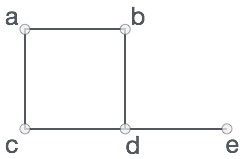
在上圖中,
V = {a, b, c, d, e}
E = {ab, ac, bd, cd, de}
圖資料結構
數學圖可以用資料結構表示。我們可以使用頂點陣列和二維邊陣列來表示圖。在我們繼續之前,讓我們熟悉一些重要的術語:
頂點 - 圖的每個節點都表示為一個頂點。在下面的例子中,帶標籤的圓圈代表頂點。因此,A到G都是頂點。我們可以用陣列來表示它們,如下圖所示。這裡A可以用索引0標識,B可以用索引1標識,以此類推。
邊 - 邊表示兩個頂點之間的路徑或兩點之間的線。在下面的例子中,從A到B、B到C等的線表示邊。我們可以使用二維陣列來表示陣列,如下圖所示。這裡AB可以用第0行第1列的1表示,BC可以用第1行第2列的1表示,以此類推,其他組合保持為0。
鄰接 - 如果兩個節點或頂點透過一條邊相互連線,則它們是鄰接的。在下面的例子中,B與A鄰接,C與B鄰接,以此類推。
路徑 - 路徑表示兩個頂點之間的一系列邊。在下面的例子中,ABCD表示從A到D的路徑。
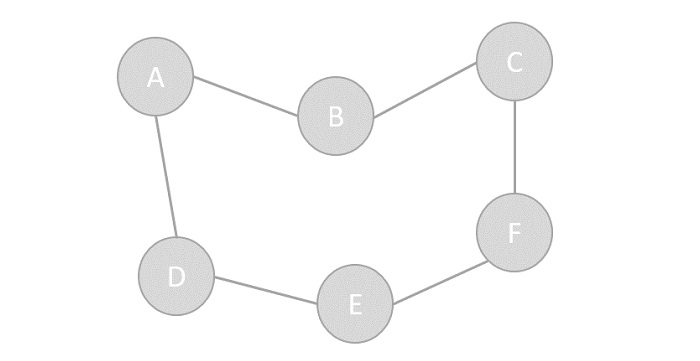

圖的操作
圖的主要操作包括建立一個帶有頂點和邊的圖,以及顯示該圖。但是,使用圖執行的最常見和最流行的操作之一是遍歷,即以特定順序訪問圖的每個頂點。
圖中有兩種型別的遍歷:
深度優先搜尋遍歷
深度優先搜尋是一種遍歷演算法,它按照其深度的遞減順序訪問圖的所有頂點。在這個演算法中,選擇一個任意節點作為起點,透過標記未訪問的鄰接節點來回遍歷圖,直到所有頂點都被標記。
DFS遍歷使用棧資料結構來跟蹤未訪問的節點。
點選檢視 深度優先搜尋遍歷
廣度優先搜尋遍歷
廣度優先搜尋是一種遍歷演算法,它在移動到下一層深度之前訪問圖中同一層深度上存在的所有頂點。在這個演算法中,選擇一個任意節點作為起點,透過訪問同一深度級別上的鄰接頂點並標記它們來遍歷圖,直到沒有剩餘頂點。
DFS遍歷使用佇列資料結構來跟蹤未訪問的節點。
點選檢視 廣度優先搜尋遍歷
圖的表示
在表示圖時,我們必須仔細描繪圖中存在的元素(頂點和邊)以及它們之間的關係。圖解地,圖用有限的節點集和它們之間的連線連結來表示。但是,我們也可以用其他最常用的方式表示圖,例如:
鄰接矩陣
鄰接表
鄰接矩陣
鄰接矩陣是一個 V x V 矩陣,其值填充為 0 或 1。如果 Vi 和 Vj 之間存在連結,則記錄為 1;否則為 0。
對於下面給定的圖,讓我們構造一個鄰接矩陣:
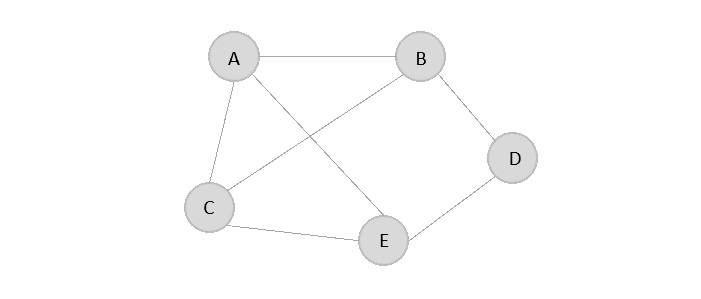
鄰接矩陣是:
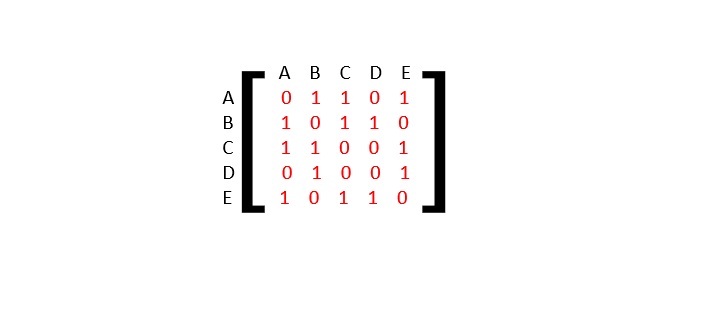
鄰接表
鄰接表是直接連線到圖中其他頂點的頂點的列表。

鄰接表是:
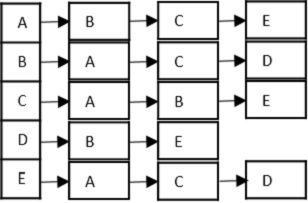
圖的型別
圖主要有兩種型別:
有向圖
無向圖
顧名思義,有向圖由具有方向的邊組成,這些方向要麼遠離頂點,要麼指向頂點。無向圖的邊完全沒有方向。
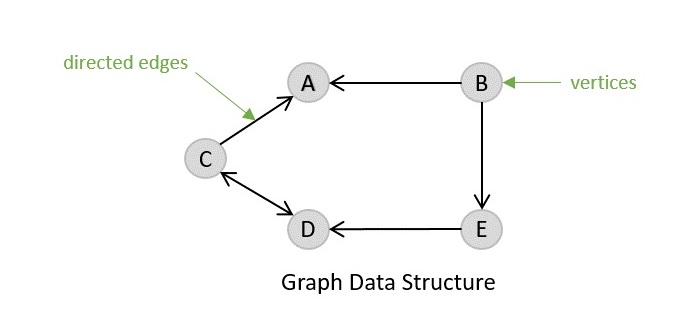
有向圖
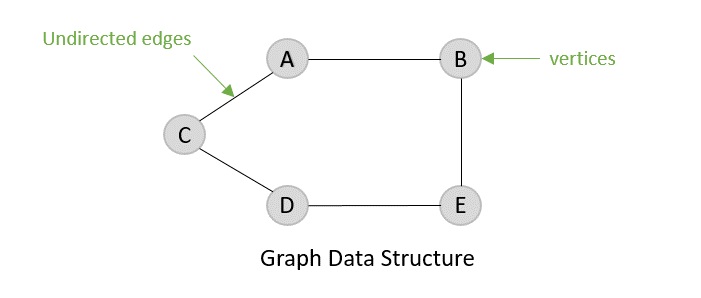
無向圖
生成樹
一個生成樹是無向圖的子集,它包含以圖中最小數量的邊連線在一起的圖的所有頂點。精確地說,生成樹的邊是原始圖中邊的子集。
如果圖中的所有頂點都連線在一起,則至少存在一個生成樹。在一個圖中,可能存在多個生成樹。
屬性
生成樹沒有任何環。
可以從任何其他頂點到達任何頂點。
示例
在下圖中,突出顯示的邊構成一個生成樹。
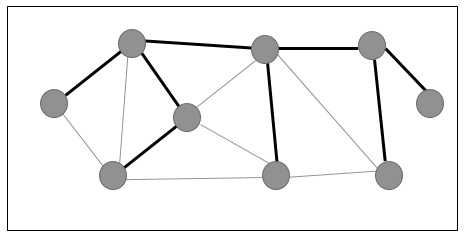
最小生成樹
最小生成樹 (MST) 是連線加權無向圖的所有頂點的邊的一個子集,其總邊權重最小。要匯出 MST,可以使用 Prim 演算法或 Kruskal 演算法。因此,我們將在本章中討論 Prim 演算法。
正如我們所討論的,一個圖可能有多個生成樹。如果有 n 個頂點,則生成樹應具有 n − 1 個邊。在這種情況下,如果圖的每條邊都與權重相關聯,並且存在多個生成樹,我們需要找到圖的最小生成樹。
此外,如果存在任何重複的加權邊,則該圖可能具有多個最小生成樹。
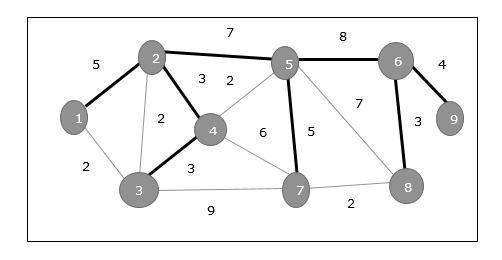
在上圖中,我們顯示了一個生成樹,儘管它不是最小生成樹。此生成樹的成本為(5+7+3+3+5+8+3+4)=38。
最短路徑
圖中的最短路徑定義為從一個頂點到另一個頂點的最小成本路線。這在加權有向圖中最常見,但也適用於無向圖。
在圖中尋找最短路徑的一個常見實際應用是地圖導航。藉助各種最短路徑演算法,目的地被視為圖的頂點,路線被視為邊,這使得導航更加輕鬆便捷。兩種常用的最短路徑演算法是:
迪傑斯特拉最短路徑演算法 (Dijkstra's Shortest Path Algorithm)
貝爾曼-福特最短路徑演算法 (Bellman-Ford's Shortest Path Algorithm)
示例
以下是該操作在各種程式語言中的實現:
#include <stdio.h>
#include <stdlib.h>
#include <stdlib.h>
#define V 5
// Maximum number of vertices in the graph
struct graph {
// declaring graph data structure
struct vertex *point[V];
};
struct vertex {
// declaring vertices
int end;
struct vertex *next;
};
struct Edge {
// declaring edges
int end, start;
};
struct graph *create_graph (struct Edge edges[], int x){
int i;
struct graph *graph = (struct graph *) malloc (sizeof (struct graph));
for (i = 0; i < V; i++) {
graph->point[i] = NULL;
}
for (i = 0; i < x; i++) {
int start = edges[i].start;
int end = edges[i].end;
struct vertex *v = (struct vertex *) malloc (sizeof (struct vertex));
v->end = end;
v->next = graph->point[start];
graph->point[start] = v;
}
return graph;
}
int main (){
struct Edge edges[] = { {0, 1}, {0, 2}, {0, 3}, {1, 2}, {1, 4}, {2, 4}, {2, 3}, {3, 1} };
int n = sizeof (edges) / sizeof (edges[0]);
struct graph *graph = create_graph (edges, n);
printf("The graph created is: ");
for (int i = 0; i < V; i++) {
struct vertex *ptr = graph->point[i];
while (ptr != NULL) {
printf ("(%d -> %d)\t", i, ptr->end);
ptr = ptr->next;
}
printf ("\n");
}
return 0;
}
輸出
The graph created is: (1 -> 3) (1 -> 0) (2 -> 1) (2 -> 0) (3 -> 2) (3 -> 0) (4 -> 2) (4 -> 1)
#include <bits/stdc++.h>
using namespace std;
#define V 5
// Maximum number of vertices in the graph
struct graph {
// declaring graph data structure
struct vertex *point[V];
};
struct vertex {
// declaring vertices
int end;
struct vertex *next;
};
struct Edge {
// declaring edges
int end, start;
};
struct graph *create_graph (struct Edge edges[], int x){
int i;
struct graph *graph = (struct graph *) malloc (sizeof (struct graph));
for (i = 0; i < V; i++) {
graph->point[i] = NULL;
}
for (i = 0; i < x; i++) {
int start = edges[i].start;
int end = edges[i].end;
struct vertex *v = (struct vertex *) malloc (sizeof (struct vertex));
v->end = end;
v->next = graph->point[start];
graph->point[start] = v;
}
return graph;
}
int main (){
struct Edge edges[] = { {0, 1}, {0, 2}, {0, 3}, {1, 2}, {1, 4}, {2, 4}, {2, 3}, {3, 1} };
int n = sizeof (edges) / sizeof (edges[0]);
struct graph *graph = create_graph (edges, n);
int i;
cout<<"The graph created is: ";
for (i = 0; i < V; i++) {
struct vertex *ptr = graph->point[i];
while (ptr != NULL) {
cout << "(" << i << " -> " << ptr->end << ")\t";
ptr = ptr->next;
}
cout << endl;
}
return 0;
}
輸出
The graph created is: (1 -> 3) (1 -> 0) (2 -> 1) (2 -> 0) (3 -> 2) (3 -> 0) (4 -> 2) (4 -> 1)
import java.util.*;
//class to store edges of the graph
class Edge {
int src, dest;
Edge(int src, int dest) {
this.src = src;
this.dest = dest;
}
}
// Graph class
public class Graph {
// node of adjacency list
static class vertex {
int v;
vertex(int v) {
this.v = v;
}
};
// define adjacency list to represent the graph
List<List<vertex>> adj_list = new ArrayList<>();
//Graph Constructor
public Graph(List<Edge> edges){
// adjacency list memory allocation
for (int i = 0; i < edges.size(); i++)
adj_list.add(i, new ArrayList<>());
// add edges to the graph
for (Edge e : edges){
// allocate new node in adjacency List from src to dest
adj_list.get(e.src).add(new vertex(e.dest));
}
}
public static void main (String[] args) {
// define edges of the graph
List<Edge> edges = Arrays.asList(new Edge(0, 1),new Edge(0, 2),
new Edge(0, 3),new Edge(1, 2), new Edge(1, 4),
new Edge(2, 4), new Edge(2, 3),new Edge(3, 1));
// call graph class Constructor to construct a graph
Graph graph = new Graph(edges);
// print the graph as an adjacency list
int src = 0;
int lsize = graph.adj_list.size();
System.out.println("The graph created is: ");
while (src < lsize) {
//traverse through the adjacency list and print the edges
for (vertex edge : graph.adj_list.get(src)) {
System.out.print(src + " -> " + edge.v + "\t");
}
System.out.println();
src++;
}
}
}
輸出
The graph created is: 0 -> 1 0 -> 2 0 -> 3 1 -> 2 1 -> 4 2 -> 4 2 -> 3 3 -> 1
#Python code for Graph Data Struture
V = 5
#Maximum number of vertices in th graph
#Declaring vertices
class Vertex:
def __init__(self, end):
self.end = end
self.next = None
#Declaring Edges
class Edge:
def __init__(self, start, end):
self.start = start
self.end = end
#Declaring graph data structure
class Graph:
def __init__(self):
self.point = [None] * V
def create_graph(edges, x):
graph = Graph()
for i in range(V):
graph.point[i] = None
for i in range(x):
start = edges[i].start
end = edges[i].end
v = Vertex(end)
v.next = graph.point[start]
graph.point[start] = v
return graph
edges = [Edge(0, 1), Edge(0, 2), Edge(0, 3), Edge(1, 2), Edge(1, 4), Edge(2, 4), Edge(2, 3), Edge(3, 1)]
n = len(edges)
graph = create_graph(edges, n)
#Range
print("The graph created is: ")
for i in range(V):
ptr = graph.point[i]
while ptr is not None:
print("({} -> {})".format(i, ptr.end), end="\t")
ptr = ptr.next
print()
輸出
The graph created is: (0 -> 3) (0 -> 2) (0 -> 1) (1 -> 4) (1 -> 2) (2 -> 3) (2 -> 4) (3 -> 1)